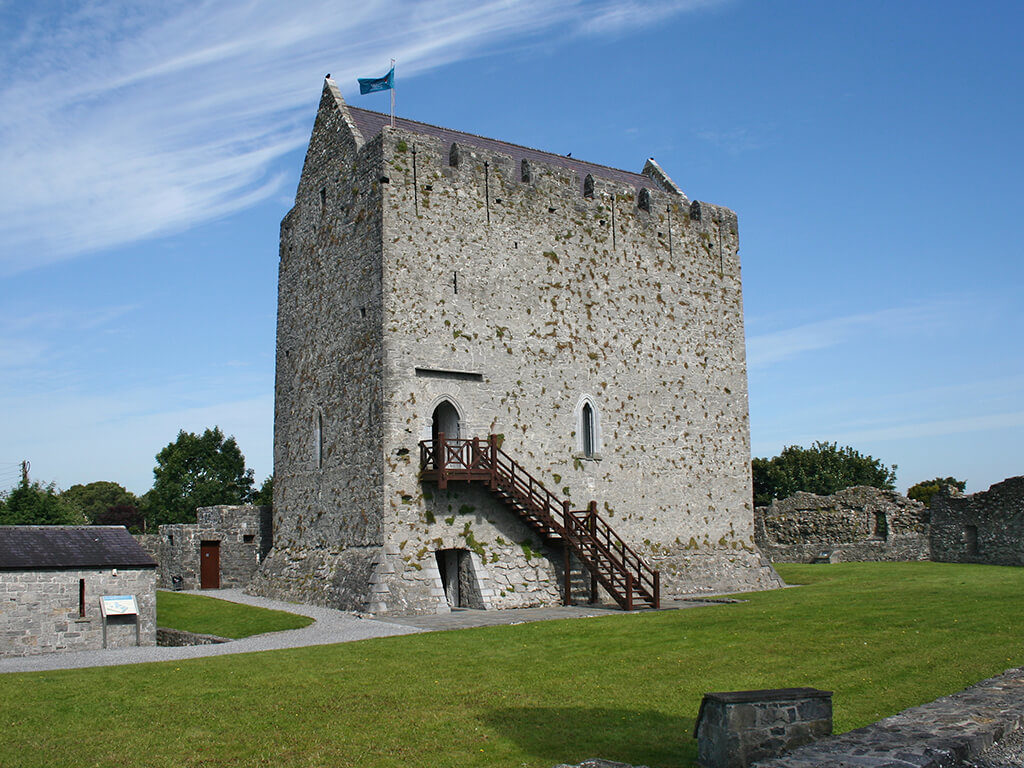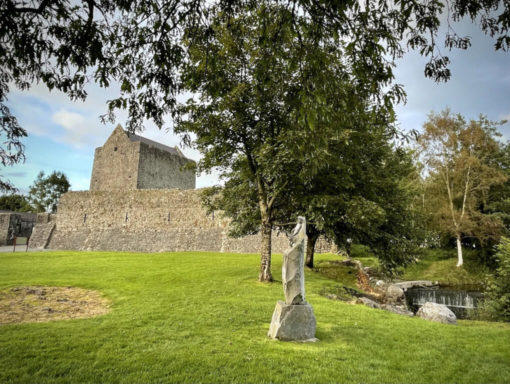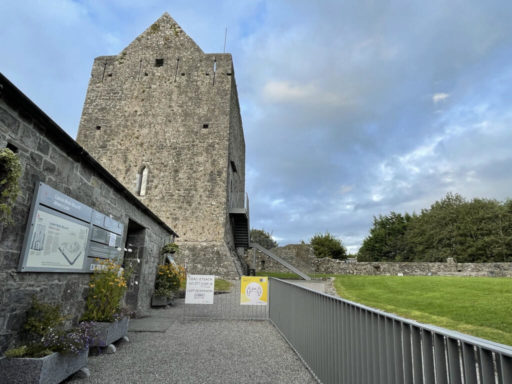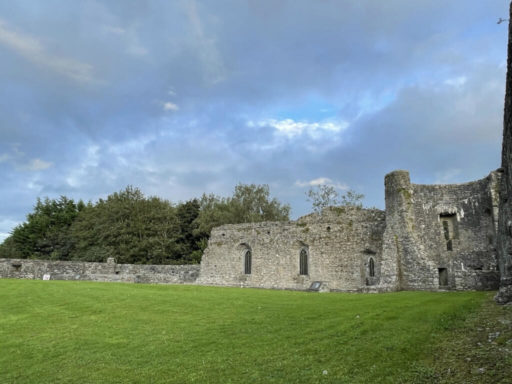
Athenry Castle
Discover the medieval past of Athenry
Athenry Castle is one of the best castles in Galway to visit and an ideal place for visitors to start learning about the town’s history. It is the starting point from where the town has grown. There has been considerable debates on the date that the castle started being built. It was sometime after 1235 when Meiler be Bermingham, Second Baron of Athenry was granted a charter to build his castle by Richard de Burgo, Lord of Connaught. Most records state 1238 as the date but there is sufficient evidence to suggest that it could also be 1240.
For over five centuries the castle lay in ruins. In 1990, a decision was made by the National Monuments branch of the Office of Public Works to begin restoring it. Today its towering presence over the town is a beautiful presence in the day and night, in particular at night when the spot lights highlight this magnificent monument. It stands in full glory today which is a testament to those involved in its restoration.
Athenry Castle in pictures
Entering the castle
On entering the gates one begins to realise how importance this historical site is and why we should never forget our roots. You will see on your right the remains of what was a Banquet Hall. One tower stood on either side of it and one of these is still in good condition.
The Basement is the first room on the bottom floor of the castle. Here they stored goods and weapons. Its only entrance was through a trap door in the ceiling. It wasn’t until the 15th Century that a main entrance was built on the ground. This would have enabled them to store larger goods. A main feature of the Basement is the arch-like features on the ceiling, built to support the room.
When the castle was built great measures were taken to ensure that it was properly protected. Slited windows or loops as they are called can be seen throughout the castle. These formed the basis of the castle’s defence. They provided a great view for the soldier to attack its enemy from the inside and still kept him well protected. There are three loops in the Basement.
On visiting the castle you will discover that there are three stories in it. When it was first built by Meiler de Bermingham it was a low squat. Fifteen years later, Meiler’s son, his successor, Piers de Bermingham raised the first floor room to make it a more comfortable and spacious living area. This first floor room is called the Great Hall.
The entrance to the Great Hall is the main entrance to the castle. It was entered by climbing a flight of external stairs. As part of the castle’s defence it could not be entered from the ground. The first unique feature of this castle is the stone canopy built over the doorway so as to provide shelter for the visitors at the door. The Great Hall was a place of social interaction. They ate, drank and entertained here. This room has one feature that is unique to Athenry castle. There are four loops (lookouts) in this room. The two larger ones and the doorway display some of the 13th Century’s finest stone carvings. These carvings were common in churches of the time but this is the only Norman castle that has these carvings. At this time this would have been the uppermost room of the castle. It would have been heated by a central hearth and the smoke would have escaped through the rafters out an opening or louvre.
The castle for its time was quite modern. At the back of the Great Hall a garderobe or toilet was built. It is a small narrow room with an opening onto a pit in the ground floor. There are two loops on either side of it so enemies could be seen at all times.
At this time the castle would have been well heated by the central hearth. When two floors were added to it in the 15th Century it was impossible to hold onto the fireplace because the smoke had no exit to escape. The castle was now cold and damp. The de Berminghams moved out around this time and decided to live in a more dwellings near the market square.
These two extra floors dramatically changed the look of the castle and did provide better lookouts for defence. On the second floor is the Garrison. There is one loop here. Here you will see a stone stairway embedded into the castle’s outer wall. This leads up to a wall walk around the roof of the castle. The Mural Stairs provided soldiers with a great view of the countryside on all sides of the castle.
Audio visual display
A 20 minutes video presentation is provided here. It presents information about Athenry and surrounding areas. It gives visitors a taste of some of the historical sites around Galway county. In the 16th Century the Normans became more Irish than the Irish themselves by dropping their own native french language and adopting the Irish one. By now the integration of the two cultures was indeed a successful one because the Normans began to marry into Irish families.
Finally the top floor, the Attic, provided soldiers with great views of oncoming enemies. Today it provides visitors with fantastic views of Athenry and beyond. The Office of Public Works completed its restoration when the Attic was added.
Look inside Athenry Castle
Athenry Medieval Festival
Every year in August, people in the town celebrate their rich medieval past in a Medieval Festival. Outside the castle a battle takes place and the castle is defended against attack. Athenry is one of the finest examples of an authentic mediaeval town. Athenry castle was the beginning of the town’s existence and now that it has been magnificently restored, it is one of the most popular heritage sites in Ireland today.
Contact
Athenry Town, Co. Galway, H65 WP93
Phone: 091 844797
Email: [email protected]
Athenry Castle map
Athenry Castle FAQs
When is Athenry Castle open to the public?
Athenry Castle is usually open daily from March to November; however, check directly with the OPW (Office of Public Works) who operate the castle to confirm opening times.
What is the entrance fee for Athenry Castle?
Admission prices range from €3.00 for children/students to €13.00 for families. Note: prices are liable to change, so please check directly with the OPW.
What is the historical significance of Athenry Castle?
Athenry Castle is an immaculately preserved testament to Ireland’s medieval past, with its construction attributed to Meiler de Bermingham around 1250.
What notable architectural features are evident at Athenry Castle?
The hall-keep in Athenry Castle is a large rectangular structure featuring a hall on the first floor and dark storerooms below. The hall served as a space of grandeur and significance, where the lord hosted guests, conducted official ceremonies, and presided over the manor court.
In addition, the hall in Athenry Castle was likely heated by a central brazier, with smoke venting through a louver in the roof. The garderobe, a toilet, is strategically placed diagonally across from the main entrance.
The exterior doorway and window carvings of Athenry Castle are adorned with floral motifs in the local “School of the West” style, a transition between Romanesque and Gothic. This style is seen in structures like the abbeys of Cong, Ballintubber, and Boyle, dating back to the late 12th and early 13th centuries.



